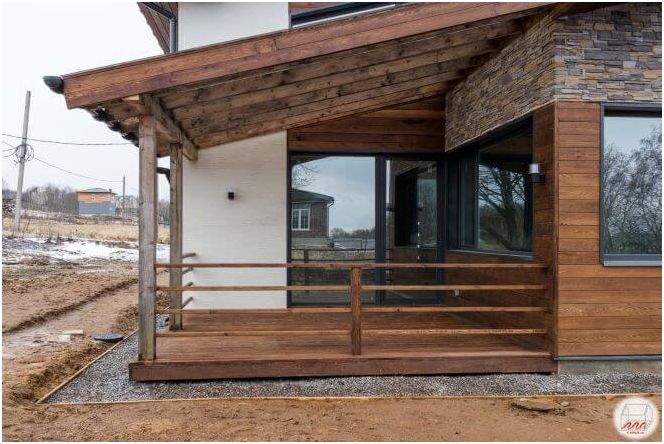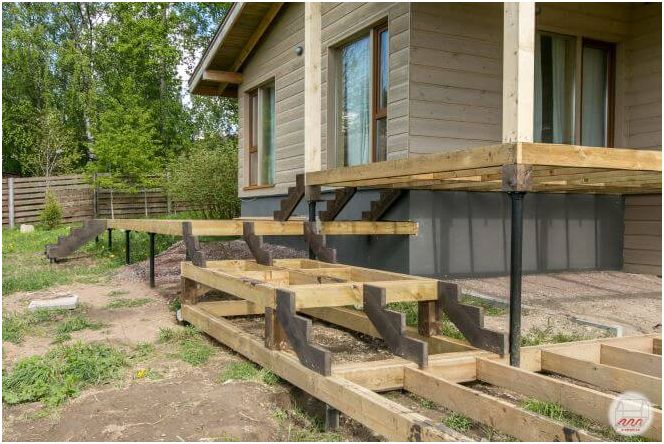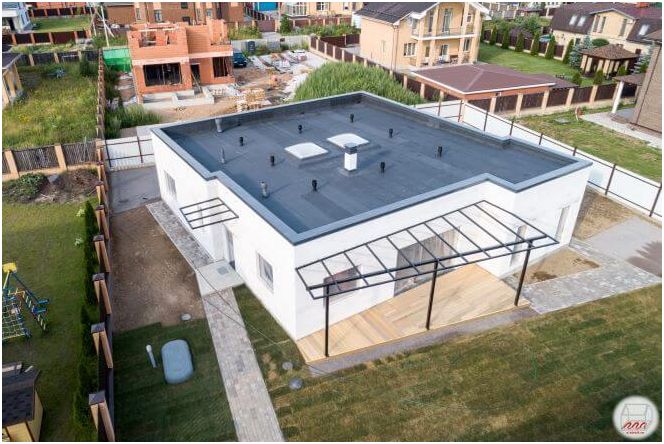A terrace is a place that can be aesthetically decorated and used for comfortable spending free time. Terrace slab is most often used as a floor covering in Russia. This is a special element of an open or closed area, emphasizing its aesthetics. Many manufacturers supply the market with terrace tiles, which represent an original combination of natural colors and interesting textures..
What is a terrace slab?

Before you begin a thorough analysis of the building material, you should figure out what it represents. This is a floor building material for cladding terraces in country houses and cottages, as well as for finishing other surfaces. It can be used outdoors, has high frost resistance, resistance to sudden temperature changes, high humidity.
Defects are excluded in the manufacture of products, the building material is a high-quality, safe product. You can lay the flooring yourself, but it is better to entrust the work to professionals who will be able to lay the tiles taking into account the technology.
What should be a terrace slab?
The construction of a terrace is not so much laborious as it is responsible. Based on the available area, it is possible to build a platform that will be in harmony with the facade of the building, as well as provide comfort of use. You can use a slab imitating wood, clinker or concrete tiles, as well as paving stones.
The choice of a suitable solution depends on the following factors:
- site structures;
- its location;
- climate in a given place;
- security.
- User, prices.
Many shops and manufacturers offer a wide range of such building materials. You can buy tile products that differ in size, shape, color, structure.
When choosing the right building material, consider certain criteria. The material is used outside, so pay attention to frost resistance. It must be designed so that it does not crack in the cold and is durable. Choose building materials with high moisture resistance, low porosity. Thanks to this, in winter, they do not crack when increasing..
Another factor is slip resistance. The tile should have a high degree of anti-slip, which is important in winter and rain. The degree of slip resistance should be above ten units, which provides increased grip of the foot or shoe with the ground. Another factor is the hardness of the building material. This is a very important feature because the harder slabs are less damaged and less likely to deform. If the flooring has a Mohs hardness of 6 to 8, it can be used even on frequently used sites..
What types of terrace tiles are available on the market?

The first type is a concrete deck slab. It is highly durable and less prone to abrasion. The advantages of this material include many colors and shapes. Concrete products imitating stone have characteristics similar to classic concrete building materials, but are more aesthetically pleasing. The use of a concrete slab gives a variety of patterns and textures, which means the possibility of creating original patterns. Thanks to modern technologies, it is possible to create not only classic rectangular and square products in gray, but also tiles with unusual colors and patterns. The production uses concrete grade 500, quartz sand. Shading of products is carried out using different pigment dyes. The products are intended for laying on terraced areas without a foundation. Laying is carried out on a compacted sand cushion. Filling thick joints is carried out using coarse sand or water and frost-resistant grout. In the process of installation on the ground, in order to prevent the penetration of vegetation, as well as the subsidence of some elements, a mortar on a cement-sand base is preliminarily laid (layer from 10 to 20 mm).
The second type is clinker products, which are strong and durable, as well as resistant to weather conditions and ultraviolet radiation. You can buy it in a matte look, but then it requires impregnation. Clinker hardness is about 2%. Also on the market is porcelain stoneware tiles. It is a practical, moisture-resistant, frost-resistant material that practically does not deform and does not wear out when used..
Another type is wood decking or woodgrain decking. These types of panels are suitable for old style houses. They can also be used on terraces in modern homes for a retro look. Terrace wooden tiles are more expensive than wooden ones. Also, for the arrangement of sites of any type, polymer-sand products are used, in the production of which the technology of manufacturing tiles is used. During production, special polymer mastics are added to the solution based on cement and sand, due to which the product acquires high strength and resistance to bending. Thus, the thickness of the slab is reduced, but its performance remains the same. In other words, 20mm tiles remain as strong as 50mm concrete products. Moreover, the latter weigh twice as much.
Which terrace tiles to choose: porcelain stoneware or clinker

Arranging the site with ceramic tiles is a practical and aesthetic solution. The beauty of such a flooring is very easy to maintain. The adjoining terrace is a kind of continuation of the living room. The originality of the site can be emphasized by the use of decorative tiles. Most often, clinker tiles or porcelain stoneware are used for finishing work. Floor material is selected for the finish or color of the facade, but it will also not be a mistake to select the panels in the room from which we go to the site. There are many types of building materials on the market. They differ in color, ranging from snow-white views to black, matching the color of the tiles of modern buildings. Also, many manufacturers produce building materials for concrete, which are combined with the facades of buildings made in the style of modern architecture. Unique solution – wood imitation slabs.
The floor covering on the terrace must withstand low temperatures, abrasion, and have an anti-slip surface. Materials that absorb a large amount of water will crack in the cold, therefore, products with a water absorption of no more than 3% are suitable for a terrace. Builders recommend choosing surfaces that are resistant to abrasion, as these are likely to be contaminated from the ground. Abrasion class must be at least III. The sliding index of the coating must not be lower than R10. It is not recommended to lay glazed or polished slabs on the terrace, as it will slip a lot in rain and in winter..
Porcelain stoneware tiles for the terrace – features
This building material is used for laying in open areas very often. It is distinguished by high strength, durability, wear resistance, resistance to mechanical damage, not afraid of temperature extremes, and has low water absorption. The front side of such a tile has different surfaces: polished (natural) or glazed (with a layer of glaze). The big advantage of the building material is its low porosity, therefore, it practically does not get dirty, it tolerates contact with acids and chemicals well. The finish of the slabs also varies. There are products on the market with the presence of patterns, made in different colors, imitating different types of stones, wood.
The thickness of the slabs may vary. On the market, you can order tile materials with a thickness of 6 to 10 mm. Previously, you can buy tiles with a thickness of 2 cm, but it has not become widespread. In Russia, thin products with a thickness of 6 mm are in demand, as well as large slabs with a size of 80×180 cm.
Clinker terrace slab – features

Clinker materials have low water absorption and are frost-resistant. Also, clinker is a synonym for the words durability, strength, wear resistance. Due to the fact that they do not absorb dirt, it is very easy to care for clinker board surfaces. There are many types and collections of terrace tiles on the market. In size, products are smaller than porcelain stoneware slabs.
Clinker is chosen by people who want to equip a high-quality street area. Building material will not collapse under the influence of snow and rain, it will be able to withstand the weight of any furniture.
Among the main advantages:
- High wear resistance.
- Resistance to temperature extremes.
- Use in humid environments.
- Non-porous structure with smoothness.
- UV resistance.
- Antifungal coating prevents fungi and bacteria from growing.
- Anti-slip properties due to the rough surface (on such a coating you will not slip in the rain or in frost).
These tiles are available in many color variations. This is a good opportunity to create a unique design for indoor and outdoor areas..
What terrace slabs look like?

The collections of porcelain stoneware and clinker slabs intended for terrace cladding include not only basic products for the floor and basement, but also materials with anti-slip recesses. They can even be used on the edges of low terraces or stairs leading to the landing. The line of clinker materials includes models with a protrusion on a single edge.
Products of any size are suitable for arranging terraces, but it is correct to select materials for the size of the site. The larger the terrace, the better large materials will look. In many lines, there are elements in different sizes, which allows them to be aesthetically combined and combined into a single composition. For a small site, a material with dimensions of 30×30 cm is suitable.Among large formats, products with dimensions of 80×80 or 120×120 cm are popular.
Terrace tile cleaning – what you need to know?

Concrete, clinker or wood tiles have their own charm. However, their appearance depends on the users and the correct handling of the terrace floor. Regardless of the type of terrace, its surface should be thoroughly cleaned. It is very important to clean the floor regularly, especially from spring to autumn, when the terrace is used the most. This can be done with special detergents for terrace tile materials. However, do not forget to thoroughly clean the entire surface on the terrace..
One of the best homemade ways to remove dust and other dirt from a surface is to rinse it with water and ammonia. It is enough to wipe the surface of the terrace to keep it clean. The trouble for users in the case of such coatings is the cleaning of the solution between the terrace tiles. Any dirt that is really troublesome should be sanded with sandpaper, but be careful not to damage the surface of the plate itself. In addition to cleaning, the stoves must be properly maintained. For this, impregnations are used that protect the terrace from frost, bloom and stains..

